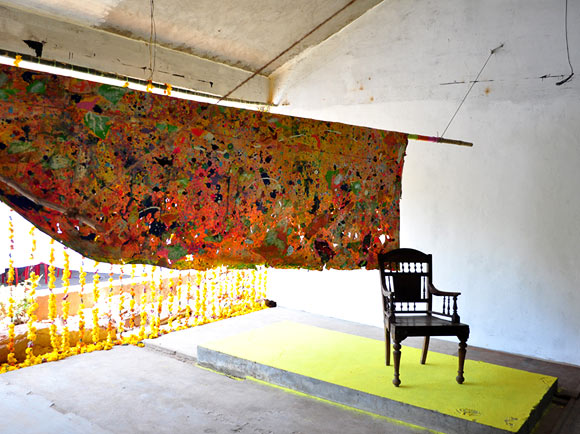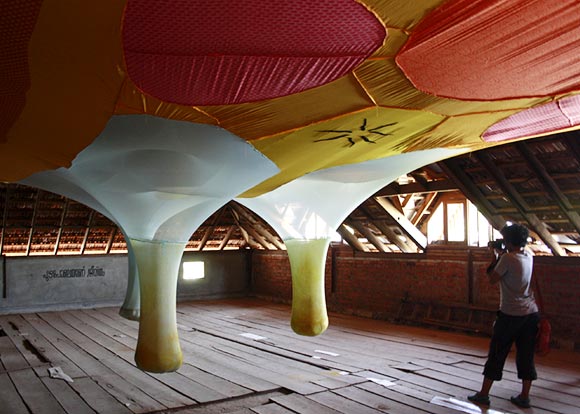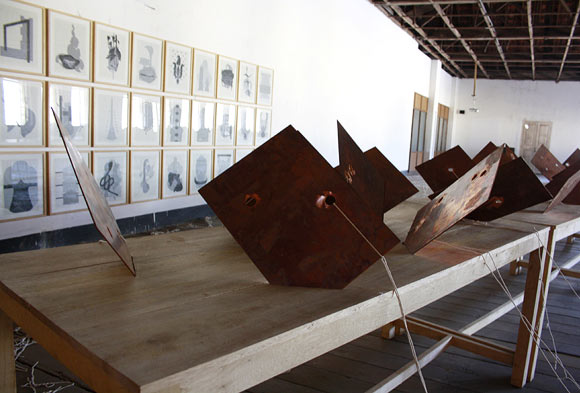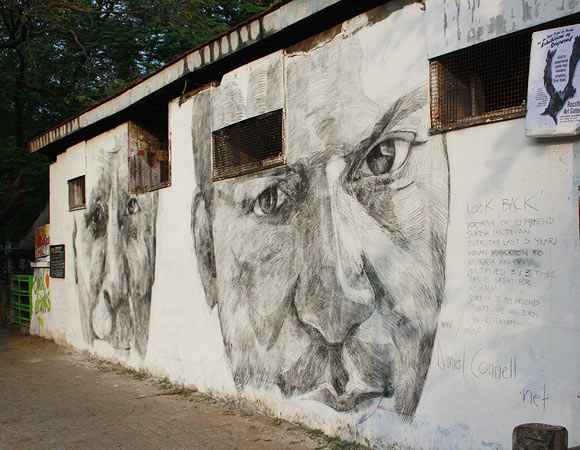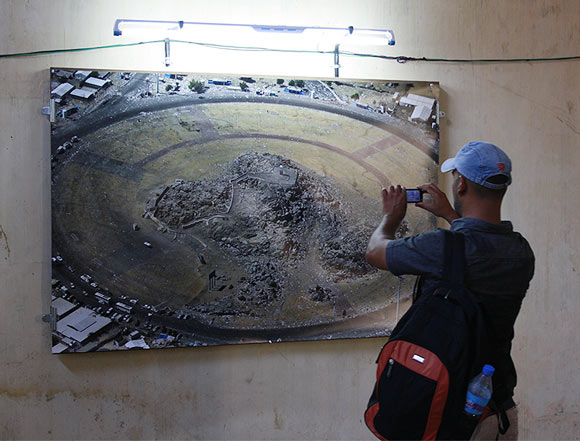 | « Back to article | Print this article |
Kochi Biennale: Art that challenges!
Instead of snoozing under the sun on India's Western coast, the port town of Kochi is soaking in the limelight of hosting India's first-ever New-Age art extravaganza.
It is playing host to 88 artists from 24 countries who have set up their exhibit for the three-month long Kochi-Muziris Biennale that ends on March 13.
Durga Dominic and Rajesh Karkera bring you glimpses of the extraordinary international artistes who are participating in the Biennale.
Earlier in the series:
Don't miss! The incredible Kochi Biennale
Kochi Biennale: A magnificent visual feast!
Clifford Charles: South Africa
Visual artist Clifford Charles was the first black student to graduate in fine arts from the University of the Witwatersrand at a time when apartheid was still rampant in South Africa.
An artist who believes in breaking boundaries, he is enamoured with the energy and space found in Kochi and the subtle mix of what can be achieved when you break the boundaries of both.
Charles, whose work was vandalised at the Biennale, says: "When you start attacking the painting, you are not thinking about the creative process."
Artist information courtesy: pallant.org.uk; kochimuzirisbiennale.org
Please click Next to see more wonderful art...
Jonas Staal: The Netherlands
Dutch visual artist Jonas Staal's work deals with the relationship between art, politics and ideology and often generates public debate.
Last May, he announced the establishment of the artistic and political organisation, New World Summit.
It is dedicated to providing 'alternative parliaments, hosting organisations that currently find themselves excluded from democracy by means of so-called international designated terrorist lists'.
The Kochi installation has 45 billboards depicting the flags of banned outfits, including 24 from India, at the Pavilion Of The New World Summit at Aspinwall House.
This has led to a lot of opposition, with protestors calling his work anti-national.
"What you see here," he explains, "is the third New World Summit. We will invite between six to 12 representatives of organisations blacklisted in India. We would like them to tell an alternative history of India, where it becomes clear there is a fundamental relation between colonialism and these banned organisations."
The summit is expected to be held in March, at the end of the biennale.
"What we are doing here is not illegal," he says, "so the State or police have no reason to interfere."
Additional inputs: Wikipedia
Please click Next to see more wonderful art...
Ernesto Neto: Brazil
Ernesto Neto's installation created of cloth filled with spices.
Neto is considered a leader in Brazil's contemporary art scene.
He works with abstract installations which often take up an entire exhibition space.
Generally, he uses materials that are gossamer-thin, light and stretchable.
Visitors are encouraged to touch, poke and walk on or through his exhibits so that they can experience his work and interact with it.
Life Is Like A River, Neto's exhibit in Kochi, is an installation created of cloth filled with spices.
Keeping the ethnicity of the venue alive, he has used fabric that is easily found in Kochi's markets.
Additional inputs: designboom.com; kochimuzirisbiennale.org
Please click Next to see more wonderful art...
M.I.A: United Kingdom
M.I.A.'s installation highlights the fact that ancient Indian wisdom has been buried under present day detritus.
Of all the artists exhibiting at the Kochi Biennale, M.I.A. may probably be the only name recognised by those who are not passionate about art.
Mathangi 'Maya' Arulpragasam, the Sri Lankan-born multi-talented 37 year old, is a singer, songwriter, painter and director. M.I.A. is a play on her own name as well as a reference to the abbreviation for Missing In Action.
She began her career as a visual artist, filmmaker and designer in West London in 2000, before beginning her a successful recording career in 2002 -- she has been nominated for an Academy award, two Grammy awards and the Mercury prize.
M.I.A. told Vogue India she was excited about associating with the Kochi Biennale since it is the first such event in India. 'In the West,' she said, 'the concept of art is everywhere. But India doesn't have any organised space for it yet. That's why it's exciting and more challenging to come here and start from scratch.'
Explaining her exhibit to The Hindu, M.I.A. said it was conceptualised on the fact that ancient Indian wisdom lies buried under a heap of present day plastic, plastic of credit cards, holograms and lenticular materials (printed images with an illusion of depth, or the ability to change or move as the image is viewed from different angles.)
Additional inputs: Wikipedia
Please click Next to see more wonderful art...
Hossein Valamanesh: Australia
Hossein Valamanesh was born in Tehran, but migrated to Australia in 1973.
His installation at the Kochi Biennale is a grid of black-and-white pillars made of cloth, some of which are illuminated from within. They are suspended above Indian carpets. White light falls in perfect spheres on the centuries-old patterns.
Though none of the rugs are prayer carpets, visitors are asked to remove their shoes. One gets a calm, meditative feeling on entering the room.
Valamanesh aims to seduce the viewer into thinking this is a holy place, and later get them to question why this brings out the feelings that are associated with these places when his installation is, in fact, is fake.
"The idea originated from my personal confusion about places of worship," Valamanesh says. "I rejected the idea of God and religion early on."
"I wanted to investigate this architecture of seduction; that is why this place is so calm, so beautiful. But when you look at the structure closely, everything is fake. There is no solidity to it. The columns have no bases, everything is suspended."
"The black columns represent the negative aspects of religions that suck all the energy, suck all the light."
Please click Next to see more wonderful art...
Sun Xun: China
Sun Xun represents the younger generation of Chinese artists who combine traditional and new media.
The 32 year old's meticulous hand-drawn animations -- each animation is made from hundreds of individual drawings -- have been screened at new media and film festivals in China, France, Germany and at the Anthology Film Archives in New York.
After completing his degree at the China Academy of Fine Arts in printmaking, Sun founded an animation studio Pi in 2006.
His work incorporates text written in Malayalam which, when translated, reads, 'History is a lie of time' and 'Expel truth.'
Additional inputs: corkingallery.com
Please click Next to see more wonderful art...
Joseph Semah: The Netherlands
Joseph Semah was born in Iraq, but lived in Israel until the mid-1970s.
His installation at the Kochi Biennale tells the visitor about the 72 privileges that were granted to the Jewish and Christian communities by the last ruler of the Chera dynasty.
This fascinated Semah, who also admires the resulting religious harmony in the city. "Once can't see this kind of balance anywhere else but in Kochi which history will probably tell has to do with the 72 privileges," he says.
The artist has decoded the 72 privileges into images which are hung on the wall.
In addition, it features a 22-meter-long wooden table into which 72 copper plates are inserted.
Through holes which correspond to the star constellations above the city of Jerusalem at the time the privileges were granted, 5,000 metres of white thread -- representing the whole Old City of Jerusalem -- woven and left spread on the floor.
Semah's installation includes a video performance of eight people from eight different religions standing with their backs against each other and pushing each other, creating an unharmonised dance while reading from their holy books.
Please click Next to see more wonderful art...
Angelica Mesiti: Australia, France
Angelica Mesiti's video installation at the Kochi Biennale, is about immigrant musicians.
Mesiti is a video, performance and installation artist who currently lives and works in Sydney and Paris.
Her projects are known for their focus on traditional music, dance performances, narratives, ballads and oral story telling traditions.
Citizens Band, Mesiti's video installation at the Kochi Biennale, is about immigrant musicians.
Each film depicts traditional music being performed in an urban environment.
These four musicians, who are immigrants, are exceptional performers. They carried their social and cultural heritage embodied within themselves even after displacement.
Please click Next to see more wonderful art...
Robert Montgomery: United Kingdom
London-based Scottish artist Robert Montgomery goes about at night illegally plastering over advertisements with posters covered in his poetry.
His verse is presented in white typography on a black background, screaming out ideas about beauty, consumerism and hypocrisy, among other things.
Montgomery is not really a street artist. Instead, he thinks of himself as following in the wake of the Situationists, a group of European revolutionaries in the last century who constructed artistic situations (which today we might call guerrilla installations) in unexpected places, to promote their ideas.
His text based installation at the Kochi Biennale can be found at Aspinwall House. This British-era warehouse, one of the main venues at the Biennale, now carries a poem which is lit up in the night with lights.
The message reads: 'The strange new music of the crying songs of the people we left behind, Mixing as your boat touches stone here as my new bones touch your bones.'
It captures the theme of both the Biennale and Kochi, which has a rich history of absorbing people from other countries and cultures.
Additional inputs courtesy: www.independent.co.uk
Please click Next to see more wonderful art...
Daniel Connell: Australia
On the Kochi Carnival Office walls, one of the oldest buildings in Fort Kochi, Australian visual artist Daniel Connell has created large, hand-drawn images of indigenous Australians.
Looking Back, his project, uses a blend of paste-up and street drawings to explore the links between indigenous Australia and south India.
Over two weeks, three large size faces emerged to 'look back' in goodwill and understanding not only at passers-by, but also over thousands of years when India and Australia were just an island hop away and populations merged.
Though Connell's work was defaced by anti-Biennale protestors, he recreated his popular installation.
Artist information courtesy danielconnell.net
Please click Next to see more wonderful art...
Giuseppe Stampone: Italy
Giuseppe Stampone's multimedia installation is titled Uttam Duniya/The Perfect World.
"This is a typical rickshaw in Kochi," says Giuseppe Stampone, "with two loudspeakers belting out the song Bye Bye Baby by Marilyn Monroe. What it actually means is Bye Bye Europe."
Stampone, who was born in France, talks about a Europe in decline. The rickshaw thus becomes a symbol of a Western world in crisis, a symbol of a Europe whose economy and culture is on the decline.
The autorickshaw displays a sign which says 'Clearance Sale.' The date on the sign is the date on which the European Union was founded.
There are two small monitors inside the rickshaw. The visitor can sit inside the rickshaw and see the monitors which display Stampone's work.
Please click Next to see more wonderful art...
Ahmed Mater: Saudi Arabia
He calls himself 'a man of many masks' -- a rather apt description considering the fact that Ahmed Mater is, at 33, not just one of Saudi Arabia's most celebrated young artists.
Mater is also a qualified GP and a landscape photographer whose photographs have been exhibited widely and compiled in a book.
His display at the Kochi Biennale, Desert of Pharan/Adam, includes videos and photographs from the 2012 Hajj 2012.
Mater explains his exhibit by quoting Ibn Abbas, the respected Islamic scholar: Adam was cast down in India and Eve in Jeddah. Adam went in search of her until they met and Eve drew near to him. Therefore, the place was called Mubdalifah.They knew each other at Arafat and hence the name Arafat.
Artist information courtesy: viatraffic.com; Wikipedia
